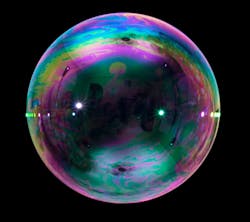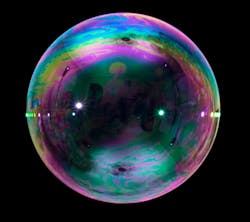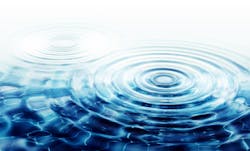Learning Optics with Austin: Lesson 10 – Interference
Besides explaining rainbows, why model light as a wave? The particle model of light is usually drawn with a particle traveling as a ray. Just by staring at a candle or light bulb however, we know that light travels in all directions. It would be impossible to draw out infinite rays traveling in all directions, so the wave model is the solution for where the particle model falls short. Instead of drawing out infinite rays of light, a wave is composed of infinite particles that are in the same phase. Each of these particles then goes on to emit their own wavefront, which is the idea behind Huygens’ Principle. As shown in the diagram below, Huygens’ Principle complements the particle model of light as rays can be drawn where the wavefronts cross.
Huyghen’s Diagram
The overlapping wavefronts naturally lead to the question of what happens when two light waves meet each other. If the following three conditions are met, then interference will take place:1) If they have the same frequency2) If they have the same direction of vibration3) If the phase difference is constant
Soap Bubble
A simple example of interference is the multi-colored surface of a soap bubble. The colorful surface is produced by a phenomenon known as thin-film interference. The science behind interference itself has a lot to do with the constructive and destructive effects of waves in general. When two light waves are in phase with each other, constructive interference results in a greater intensity of light. When light waves are out of phase with each other, destructive interference results and the light waves cancel each other (more on that in the next post!).
Constructive and Destructive Interference
Interference might seem to contradict the assumption early on that light paths are independent of one another (see “Diffraction and Refraction” post). This is not the case however, because the path of light is not being changed when two light waves meet. Light neither bounces off nor merges together. Instead, light continues on its path but either becomes brighter or dimmer depending on the interaction of light waves. While light waves are too small for the human eye to detect, interference can be demonstrated by water waves.
Water Waves
There are ways however, in which interference can be measured and studied. Read more in depth on interference in the upcoming post!
About the Author

Austin from Shanghai Optics Inc
Hello! My name is Austin and I am the host for this blog. I graduated from Rutgers in May 2021 with a Bachelor’s degree in Statistics-Mathematics and History. I interned during the summer of 2021 at Shanghai Optics working on data cleaning and analysis. I was later offered to work full-time starting in September. While my initial role was in data analytics, I realized that my knowledge of the company’s products was quite shallow as a key skill for any well-trained data analyst is to know your data. That’s how I got started on my journey in learning about optics.
I found physics interesting but challenging in high school. I did not particularly enjoy classical physics and a seminar in quantum mechanics flew over my head in college. As I see first-hand how our optics works in different applications, I’m quickly beginning to realize that Photonics has the potential to shape the present and the future. Because of my newfound enthusiasm, management took notice and I am fortunate enough to begin a Physics/Photonics class sponsored by Shanghai Optics in the fall of 2021. This blog is part of my experience in taking the class and sharing with you all the wealth of knowledge I’m acquiring!
Aside from optics, some of my personal interests include studying history and going on hikes. Both activities are great opportunities to talk with other people so feel free to ask me any questions on my personal interests or the materials I post!


